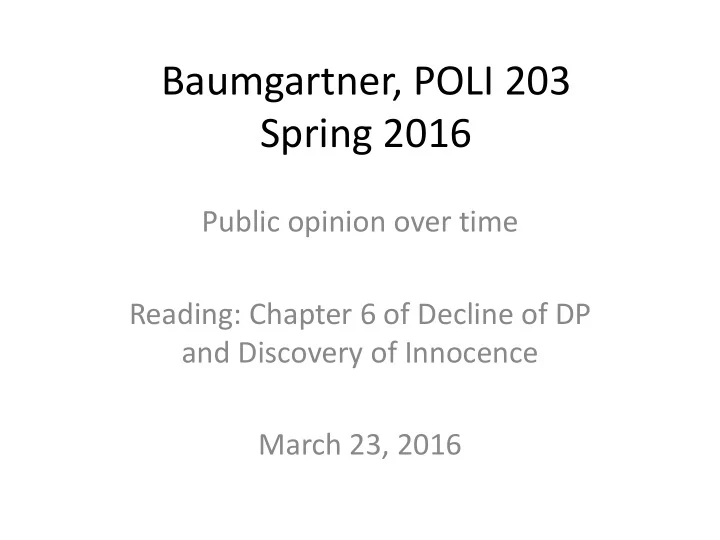

Baumgartner, POLI 203 Spring 2016 Public opinion over time Reading: Chapter 6 of Decline of DP and Discovery of Innocence March 23, 2016
Punitiveness • We grew collectively extremely punitive from the 1970s through the mid-1990s • See NYT video on web site regarding super- predators.
Public Opinion • Polls go back to 1930s, Gallup: • http://www.gallup.com/poll/1606/death- penalty.aspx • Enns on punitiveness: – https://www.washingtonpost.com/blogs/monkey- cage/wp/2015/02/15/why-the-united-states- incarcerates-so-many-people-in-one-graph/ – http://www.cambridge.org/us/academic/subjects/soc iology/criminology/incarceration-nation-how-united- states-became-most-punitive-democracy-world
Who supports, who opposes? • Support higher among: – Whites – Males – Southerners – High school education – Republicans • But it also shows aggregate trends over time – That is our focus on the chapter
Depends on the question asked • See the different results obtained from various questions from Gallup. • At other times: do you support the death penalty for convicted terrorist bomber Timothy McVeigh? (Very high results) • No “best way” to ask the question. • So we look at trends across all questions.
Support for the death penalty for particular offenders: from 32 to 82 percent
States Vary by Opinion, Obviously
But they vary a lot more in executions!
Our point: how this changes over time • Depends on the question, of course: • “Are you in favor of the death penalty for persons convicted of murder?” – (GALLUP, 42 administrations of this question) • “If you could choose between the following two approaches, which do you think is the better penalty for murder – the death penalty or life imprisonment, with absolutely no possibility of parole?” (GALLUP LIFE, 18 administrations) • “Do you favor or oppose the death penalty for persons convinced of murder?” – (NORC-GSS MURDER, 25 administrations)
3 questions, different results, same trend 100% 90% 80% 70% 60% 50% 40% 30% 20% 10% 0% 1953 1957 1961 1965 1969 1973 1977 1981 1985 1989 1993 1997 2001 2005 Gallup Murder NORC-GSS Murder Year of Survey Gallup Life
So we make an index 100% 90% 80% 70% 60% 50% 40% 30% 20% 10% 0% 1953 1957 1961 1965 1969 1973 1977 1981 1985 1989 1993 1997 2001 2005 Gallup Murder NORC-GSS Murder Year of Survey Gallup Life Combined Index
About the index • See pp. 175 and following in the book • Lots and lots of questions – 67 different survey companies – 350 different questions – 763 different administrations • That is, we took all usable information • Weighted average, shows trends
What does the index mean? • It goes up or down. • We can’t very well interpret the raw numbers, however. • The wording of the question matters a lot for the LEVEL of support. • As it turns out, it has very little impact on the TRENDS of support over time. • So we can look at trends but not really levels. • Need to look back at the individual questions for that.
Net Support • About 0 in 1965 • Rises to about +30 by 1980, stays there until 1995 • Declines to about +10 or so in 2006 • Updated in 2015, continues to go down since we did the book. See below.
Explaining Net Opinion: • Predicting that series, like we predicted Death sentences last week, same idea • Table 6.1 • Homicides: 1,000 more homicides > 3.4 increase in net opinion support • Net Tone: 10 more pro-death penalty stories > 1.5 shift in net opinion • Very slow adjustments: just 17 percent of disequilibrium per quarter
What the heck is this professor saying? • Opinion moves very slowly – No single event can be expected to cause shifts • People aren’t paying attention • People have moral views on the issue and don’t like to call those into question – Only the accumulation of years of similar events, shifting social norms over a decade or more, can be expected to shift opinion
Long- run trends, blips don’t matter • 1965-1995, one such period: lots of pro-death penalty events, opinion shifted, slowly became more accustomed, accepting of the death penalty – Note: some people will NEVER be moved by this. – But in the aggregate, opinion moves on average. • 1995-present, another such period: lots of “bad news” relating to the death penalty – Innocence, costs, laws restricting use, less use, abolition by several states, botched executions
Remember your first quiz results • People are not paying attention, obviously • So, no single event will move national opinion • But we see an accumulation over time, ever so slowly.
Should you die because of public opinion? • We can predict the number of death sentences handed down by juries by: – Opinion – Tone of news coverage – (Homicides had no effect) • So, timing matters. Same trial in 1993 v. in 2013 might or might not lead to death… Ouch!
Updates, as of April 2015, based on 488 national surveys
Combining questions into one index
Compared to 1976, +9, then -7
Opinion tracks violence and homicides. Death sentences track opinion.
Compare to the UK, which abolished in 1965
UK crime opinion tracks homicides, death penalty did not
France abolished in 1981, not because of public opinion…
US no more supportive than UK, France
Recommend
More recommend